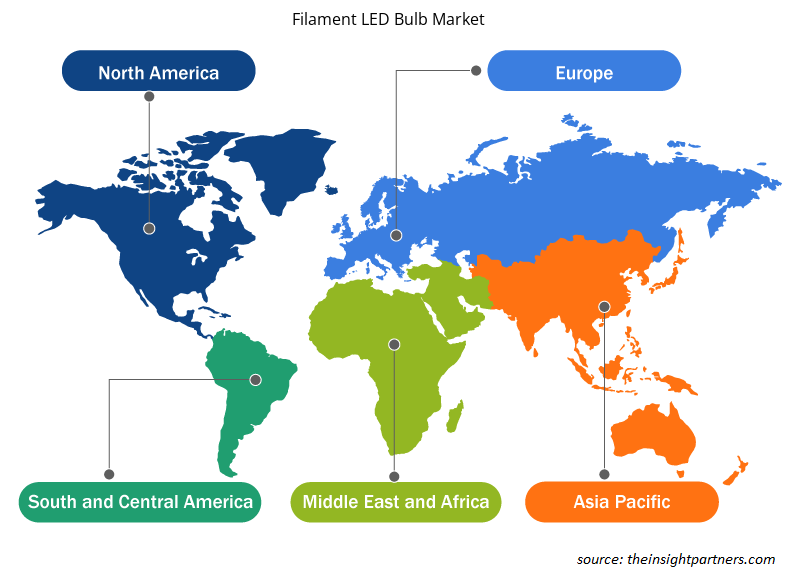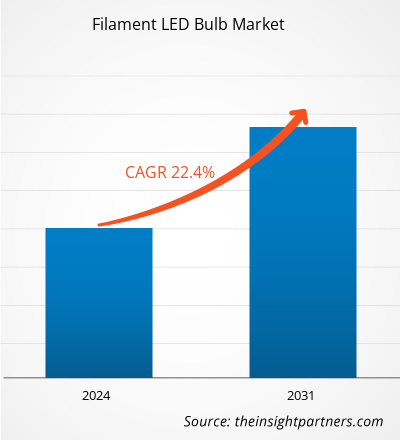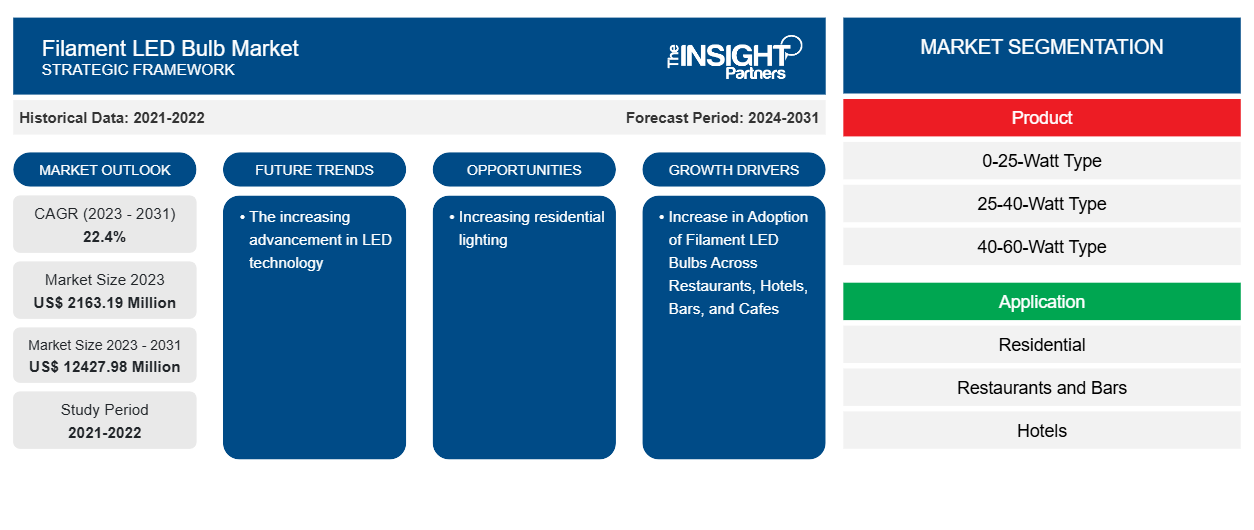Der Markt für Glühlampen mit LED-Glühbirnen soll von 2163,19 Millionen US-Dollar im Jahr 2023 auf 12427,98 Millionen US-Dollar im Jahr 2031 anwachsen. Der Markt soll zwischen 2023 und 2031 eine durchschnittliche jährliche Wachstumsrate (CAGR) von 22,4 % verzeichnen. Die zunehmende Weiterentwicklung der LED-Technologie dürfte ein wichtiger Trend auf dem Markt bleiben.
Marktanalyse für Filament-LED-Lampen
Das Wachstum des Marktes ist auf die steigende Zahl gewerblicher und privater Bauprojekte in verschiedenen Regionen zurückzuführen. Darüber hinaus steigert das zunehmende Interesse an Renovierungs- und Umbaumaßnahmen im Eigenheim, das auf eine verstärkte staatliche Förderung, insbesondere in Industrieländern, zurückzuführen ist, auch die Nachfrage nach Glühlampen-LEDs. Steigende Verbrauchereinkommen, Veränderungen im Lebensstil und die Akzeptanz unterschiedlicher Kulturen in Bezug auf die Inneneinrichtung tragen zu diesem Wandel bei.
Marktübersicht für Filament-LED-Lampen
LED-Glühlampen verbessern das Aussehen und die Lichtstreuung von Glühlampen und sorgen mit LED-Technologie für effiziente Beleuchtung und zuverlässige Leistung. LED-Glühlampen, allgemein als Edison-Glühlampen bezeichnet, zeigen große leuchtende Glühfäden durch klare Glasgehäuse und ähneln altmodischen Glühlampen oder Vintage-Lampen. LED-Glühlampen bieten das Aussehen herkömmlicher Glühlampen, bieten aber gleichzeitig energieeffiziente Beleuchtung und alle anderen Vorteile herkömmlicher LED-Beleuchtung. LED-Glühlampen haben eine längere Lebensdauer als Glühlampen.
Passen Sie diesen Bericht Ihren Anforderungen an
Sie erhalten kostenlos individuelle Anpassungen an jedem Bericht, einschließlich Teilen dieses Berichts oder einer Analyse auf Länderebene, eines Excel-Datenpakets sowie tolle Angebote und Rabatte für Start-ups und Universitäten.
-
Holen Sie sich die wichtigsten Markttrends aus diesem Bericht.Dieses KOSTENLOSE Beispiel umfasst eine Datenanalyse von Markttrends bis hin zu Schätzungen und Prognosen.
Markttreiber und Chancen für Filament-LED-Glühbirnen
Zunehmende Nutzung von Glühfaden-LED-Lampen in Restaurants, Hotels, Bars und Cafés
Die Beleuchtung ist ein wichtiges Element im Gesamtdesign von Restaurants und Cafés. In Cafés, Bars und Restaurants wird eine Lichtintensität von 150 Lux im Allgemeinen als angemessen angesehen. Andere Bereiche erfordern 100 Lux, der Lebensmittelaufbewahrungsbereich erfordert 150 Lux, der Spülbereich erfordert 300 Lux und der Kochbereich erfordert 500 Lux. Restaurants verwenden vier Arten von Beleuchtung: Allgemeinbeleuchtung, Akzentbeleuchtung, dekorative Beleuchtung und natürliche Beleuchtung. In einem Café oder Restaurant ist die Allgemeinbeleuchtung der wichtigste Aspekt. Eine homogene Beleuchtung wird erreicht, indem die Beleuchtungsgeräte gleichzeitig in einer bestimmten Reihenfolge platziert werden. Kunden werden das Restaurant als einladender empfinden, wenn es insgesamt anständig dekoriert ist. Akzentbeleuchtung kann eingesetzt werden, um die Aufmerksamkeit auf die wichtigsten oder ausgefallensten Aspekte von Restaurants zu lenken, darunter Dekor, Pflanzen, Tische oder Waren. Dekorative Beleuchtung bezieht sich auf die Beleuchtungskomponenten, die verwendet werden, um das Design zu vervollständigen. Zur Schaffung dekorativer Beleuchtung können traditionelle und moderne Beleuchtung verwendet werden. Daher fördern verschiedene Beleuchtungstechniken, die in Restaurants, Hotels, Bars und Cafés zum Einsatz kommen, die Einführung von LED-Glühbirnen und tragen so zum Marktwachstum bei.
Verbesserung der Wohnraumbeleuchtung
Die Beleuchtung in Wohngebieten nimmt zu. Die Verwendung von LED-Lampen in Haushalten unterscheidet sich von anderen Haushaltsmerkmalen wie Haushaltseinkommen und Eigentum. Unter den Haushalten mit einem Jahreseinkommen von weniger als 20.000 USD gaben 39 % an, dass LED-Lampen ihre primäre Wahl für die Innenbeleuchtung seien, während 54 % der Haushalte mit einem Jahreseinkommen von 100.000 USD oder mehr im Jahr im Jahr 2020 hauptsächlich LED-Lampen verwendeten. Die Glühfaden-LED-Lampen werden in Wohngebieten häufig verwendet. Somit schafft die zunehmende Beleuchtung in Wohngebieten mehr Möglichkeiten für den Markt für Glühfaden-LED-Lampen.
Marktbericht für Filament-LED-Glühbirnen – Segmentierungsanalyse
Wichtige Segmente, die zur Ableitung der Marktanalyse für Glühlampen-LED-Glühbirnen beigetragen haben, sind Produkt und Anwendung.
- Basierend auf dem Produkt ist der Markt für Glühlampen-LED-Lampen in 0-25-Watt-Typ, 25-40-Watt-Typ, 40-60-Watt-Typ und über 60-Watt-Typ unterteilt. Das 0-25-Watt-Segment hatte im Jahr 2023 einen größeren Marktanteil.
- Nach Anwendung ist der Markt in Wohngebiete, Restaurants und Bars, Hotels, Cafés und Sonstiges segmentiert.
Marktanteilsanalyse für Filament-LED-Lampen nach geografischen Gesichtspunkten
Der geografische Umfang des Marktberichts für LED-Glühbirnen ist hauptsächlich in fünf Regionen unterteilt: Nordamerika, Asien-Pazifik, Europa, Naher Osten und Afrika sowie Süd- und Mittelamerika.
Europa war im Jahr 2023 Marktführer für LED-Glühbirnen. In Europa zielen die Nationalen Aktionspläne für Energieeffizienz (NEEAPs) darauf ab, Investitionen in die Instandhaltung und Sanierung von Wohn- und Geschäftsgebäuden zu fördern. Darüber hinaus hat die Bereitschaft der Verbraucher, erhebliche Beträge für die Gestaltung von Wohnräumen auszugeben, ihre Aufmerksamkeit auf Einrichtungsprodukte wie Teppiche und Läufer sowie moderne und stilvolle Beleuchtungssysteme gelenkt, die die Ästhetik von Innenräumen verbessern.NEEAPs) and the National Energy Efficiency Action Plans (NEEAPs), the National Energy Efficiency Action Plans (NEEAPs) aim to promote investments in the maintenance and refurbishment of residential and commercial buildings. Further, consumers’ willingness to spend important amounts on the styling of living spaces has drawn their attention to home furnishing products such as carpets and rugs, and advanced and styled
Regionale Einblicke in den Markt für Filament-LED-Lampen
Die regionalen Trends und Faktoren, die den Markt für Glühlampen-LED-Lampen im Prognosezeitraum beeinflussen, wurden von den Analysten von Insight Partners ausführlich erläutert. In diesem Abschnitt werden auch die Marktsegmente und die Geografie für Glühlampen-LED-Lampen in Nordamerika, Europa, im asiatisch-pazifischen Raum, im Nahen Osten und Afrika sowie in Süd- und Mittelamerika erörtert.

- Erhalten Sie regionale Daten zum Markt für Filament-LED-Lampen
Umfang des Marktberichts zu Filament-LED-Lampen
| Berichtsattribut | Details |
|---|---|
| Marktgröße im Jahr 2023 | 2163,19 Millionen US-Dollar |
| Marktgröße bis 2031 | 12427,98 Millionen US-Dollar |
| Globale CAGR (2023 - 2031) | 22,4 % |
| Historische Daten | 2021-2022 |
| Prognosezeitraum | 2024–2031 |
| Abgedeckte Segmente |
Nach Produkt
|
| Abgedeckte Regionen und Länder |
Nordamerika
|
| Marktführer und wichtige Unternehmensprofile |
|
Marktteilnehmerdichte für LED-Glühbirnen: Auswirkungen auf die Geschäftsdynamik verstehen
Der Markt für Glühlampen-LED-Lampen wächst rasant, angetrieben von der steigenden Nachfrage der Endverbraucher aufgrund von Faktoren wie sich entwickelnden Verbraucherpräferenzen, technologischen Fortschritten und einem größeren Bewusstsein für die Vorteile des Produkts. Mit steigender Nachfrage erweitern Unternehmen ihr Angebot, entwickeln Innovationen, um die Bedürfnisse der Verbraucher zu erfüllen, und nutzen neue Trends, was das Marktwachstum weiter ankurbelt.
Die Marktteilnehmerdichte bezieht sich auf die Verteilung der Firmen oder Unternehmen, die in einem bestimmten Markt oder einer bestimmten Branche tätig sind. Sie gibt an, wie viele Wettbewerber (Marktteilnehmer) in einem bestimmten Marktraum im Verhältnis zu seiner Größe oder seinem gesamten Marktwert präsent sind.
Die wichtigsten auf dem Markt für LED-Glühbirnen tätigen Unternehmen sind:
- Crompton Lampen GmbH
- Havells India Ltd.
- Wipro Verbraucherbeleuchtung
- MEGAMAN
- OSRAM GmbH
- Signify Holding (Philips)
Haftungsausschluss : Die oben aufgeführten Unternehmen sind nicht in einer bestimmten Reihenfolge aufgeführt.

- Überblick über die wichtigsten Akteure auf dem Markt für LED-Glühbirnen
Neuigkeiten und aktuelle Entwicklungen zum Markt für Filament-LED-Glühbirnen
Der Markt für Glühlampen wird durch die Erhebung qualitativer und quantitativer Daten aus Primär- und Sekundärforschung bewertet, die wichtige Unternehmensveröffentlichungen, Verbandsdaten und Datenbanken umfasst. Nachfolgend sind einige der Entwicklungen auf dem Markt für Glühlampen aufgeführt:
- Feit Electric Company, Inc. („Feit Electric“), eine weltweit führende Marke für Beleuchtung und Smart Home mit Hauptsitz in Kalifornien, gab heute bekannt, dass eine Reihe von Patenten seine innovativen Glühbirnen mit sichtbaren weißen Glühfäden, die „White Filament Patente“, schützt.
(Quelle: Trellix, Pressemitteilung, Oktober 2023.)
- außerdem wurden im Januar weitere LED-Filamentlampen von Life on Products, Inc. auf den Markt gebracht. (Quelle: PamTen Inc, Pressemitteilung, Januar 2023)
Marktbericht zu Filament-LED-Glühbirnen – Umfang und Ergebnisse
Der Bericht „Marktgröße und Prognose für Filament-LED-Lampen (2021–2031)“ bietet eine detaillierte Analyse des Marktes, die die folgenden Bereiche abdeckt:
- Marktgröße und Prognose für Filament-LED-Lampen auf globaler, regionaler und Länderebene für alle wichtigen Marktsegmente, die im Rahmen des Berichts abgedeckt sind
- Markttrends für Filament-LED-Glühbirnen sowie Marktdynamik wie Treiber, Einschränkungen und wichtige Chancen
- Detaillierte PEST/Porters Five Forces- und SWOT-Analyse
- Marktanalyse für Filament-LED-Lampen mit wichtigen Markttrends, globalen und regionalen Rahmenbedingungen, wichtigen Akteuren, Vorschriften und aktuellen Marktentwicklungen
- Branchenlandschaft und Wettbewerbsanalyse, die die Marktkonzentration, Heatmap-Analyse, prominente Akteure und aktuelle Entwicklungen auf dem Markt für Glühlampen umfasst
- Detaillierte Firmenprofile
- Historische Analyse (2 Jahre), Basisjahr, Prognose (7 Jahre) mit CAGR
- PEST- und SWOT-Analyse
- Marktgröße Wert/Volumen – Global, Regional, Land
- Branchen- und Wettbewerbslandschaft
- Excel-Datensatz
Aktuelle Berichte
Erfahrungsberichte
Grund zum Kauf
- Fundierte Entscheidungsfindung
- Marktdynamik verstehen
- Wettbewerbsanalyse
- Kundeneinblicke
- Marktprognosen
- Risikominimierung
- Strategische Planung
- Investitionsbegründung
- Identifizierung neuer Märkte
- Verbesserung von Marketingstrategien
- Steigerung der Betriebseffizienz
- Anpassung an regulatorische Trends























 Kostenlose Probe anfordern für - Markt für Filament-LED-Lampen
Kostenlose Probe anfordern für - Markt für Filament-LED-Lampen